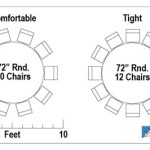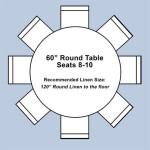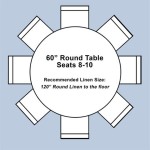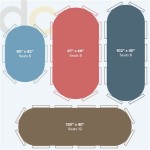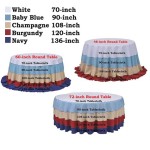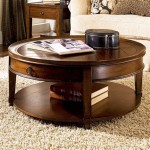How To Determine Table Runner Length of Fabric Needed
Creating a table runner can be a rewarding project, adding a touch of elegance and personality to any dining or accent table. A crucial step in this process is accurately determining the length of fabric required. This calculation ensures that the finished runner drapes appropriately and achieves the desired aesthetic. Several factors influence the necessary fabric length, including the table's dimensions, the desired overhang, and any allowances for seams and hems. Through a systematic approach, individuals can confidently calculate the fabric needed to craft a table runner that perfectly complements their table.
The process of determining the correct fabric length involves careful measurement and consideration of design preferences. Ignoring these details can result in a table runner that is either too short, failing to provide adequate coverage, or too long, creating a clumsy and impractical appearance. Therefore, understanding the key variables and applying accurate measurement techniques are paramount for a successful outcome. The following sections detail the steps involved in accurately calculating the required fabric length, covering everything from initial table measurements to accounting for finishing techniques.
Key Point 1: Measuring the Table and Determining the Desired Overhang
The first and most essential step is to measure the length of the table on which the runner will be placed. Use a measuring tape to obtain an accurate measurement from one end of the table to the other. This measurement forms the foundation for calculating the overall fabric length. Record this measurement precisely, noting whether it is in inches, centimeters, or another unit of measurement.
Following the table length measurement, the next step is determining the desired overhang. The overhang refers to the length of fabric that will cascade over the edge of the table at each end. The appropriate overhang is largely a matter of personal preference and the overall styling of the table setting. However, there are some general guidelines to consider. A standard overhang typically ranges from 6 to 12 inches on each end. For more formal settings, a longer overhang of 12 inches or more might be preferred, creating a more dramatic and elegant look.
To decide on the ideal overhang, visualize how the finished runner will look on the table. Consider the height of the chairs, the proximity of nearby furniture, and the desired level of formality. A shorter overhang of 6 to 8 inches is often suitable for everyday use and smaller tables, while a longer overhang can enhance the visual appeal of larger dining tables intended for more formal occasions. It is practical to use a piece of string or fabric to simulate different overhang lengths and assess their appearance on the table.
Once the preferred overhang length is determined, multiply this measurement by two, as the overhang will be present on both ends of the table runner. This result represents the total length of fabric needed for the overhang portion of the runner. Add this value to the initial table length measurement to obtain the preliminary total length of fabric required.
Consider, for example, a table that measures 60 inches in length. If the desired overhang is 10 inches on each end, the calculation would be as follows: 10 inches (overhang) x 2 = 20 inches (total overhang). Adding this to the table length yields a preliminary total length of 60 inches (table length) + 20 inches (total overhang) = 80 inches. This 80-inch measurement serves as the baseline for further adjustments, which will account for seam allowances and hemming.
Key Point 2: Accounting for Seam Allowances and Hems
After calculating the preliminary fabric length based on the table length and desired overhang, it is crucial to factor in seam allowances and hem sizes. Seam allowances are the extra fabric provided on each edge of the runner to facilitate secure sewing and prevent unraveling. Hems, which are typically folded and stitched edges, provide a clean and finished look while also reinforcing the fabric edges. The specific seam allowance and hem size will depend on the type of fabric used, the desired aesthetic, and the sewing techniques employed.
A standard seam allowance for most sewing projects is typically between 1/2 inch to 5/8 inch on each edge. However, for delicate or loosely woven fabrics, a larger seam allowance might be necessary to prevent fraying. Similarly, thicker fabrics may require a smaller seam allowance to avoid excessive bulk. Consider the characteristics of the fabric chosen and adjust the seam allowance accordingly. For the purposes of calculating fabric length, the seam allowance will be applied to both ends of the runner.
The hem size is another important consideration. A narrow hem, often referred to as a rolled hem, is suitable for lightweight fabrics and creates a subtle, understated finish. A wider hem, typically between 1 to 2 inches, provides a more substantial and tailored look. The choice of hem size will influence the overall fabric length needed. A wider hem requires more fabric allowance than a narrower hem.
To calculate the total fabric allowance for seams and hems, first determine the seam allowance for each end of the runner. If using a 1/2-inch seam allowance, this would require 1/2 inch + 1/2 inch = 1 inch of extra fabric for the seams. Next, determine the hem size for each end. If opting for a 1-inch hem, this would require 1 inch + 1 inch = 2 inches of extra fabric for the hems. Add the seam allowance amount to the hem allowance amount to calculate the total allowance. In this case, 1 inch (seam allowance) + 2 inches (hem allowance) = 3 inches.
Add this total allowance to the preliminary fabric length calculated earlier. Using the previous example of an 80-inch preliminary length, adding the 3-inch allowance results in a final fabric length of 80 inches + 3 inches = 83 inches. This 83-inch measurement represents the minimum fabric length required to create the table runner, accounting for both the desired overhang and the necessary seam and hem allowances.
Key Point 3: Considering Fabric Shrinkage and Pattern Matching
Beyond the basic calculations outlined above, two additional factors can influence the required fabric length: fabric shrinkage and pattern matching. Fabric shrinkage refers to the tendency of certain fabrics to shrink after washing or drying. This is particularly common with natural fibers like cotton and linen. Failing to account for shrinkage can result in a table runner that is significantly shorter than intended after its first cleaning.
To mitigate the risk of shrinkage, pre-wash the fabric before cutting and sewing. This will allow the fabric to shrink beforehand, ensuring that the finished runner maintains its correct dimensions after future washes. Consult the fabric care instructions to determine the appropriate washing and drying methods. If pre-washing, it is advisable to add an extra inch or two to the initial fabric length calculation to compensate for any potential shrinkage during the pre-wash process. This precautionary measure will safeguard against ending up with a table runner that is too short.
Pattern matching is another crucial consideration, especially when working with patterned fabrics. Pattern matching involves aligning the fabric's design elements seamlessly across seams, creating a visually cohesive and professional-looking product. This requires careful planning and often involves purchasing extra fabric to accommodate the pattern repeats. The amount of extra fabric needed for pattern matching depends on the size and complexity of the pattern.
To determine the amount of extra fabric required for pattern matching, identify the pattern repeat – the distance between identical motifs on the fabric. This is typically indicated on the fabric bolt or can be measured directly on the fabric itself. If the pattern repeat is large, more extra fabric will be needed to ensure a seamless match across the seams. When cutting the fabric, carefully align the pattern at each seam, ensuring that the design flows continuously. This may involve cutting off portions of the fabric to achieve the desired alignment, which is why purchasing extra fabric is necessary.
Given the added complexities of both pre-washing and pattern matching, it is prudent to err on the side of caution and purchase slightly more fabric than the absolute minimum calculated. This provides a buffer for potential shrinkage, cutting errors, or unexpected pattern-matching challenges. While the exact amount of extra fabric needed will vary depending on the specific fabric and pattern, adding an additional 6 to 12 inches to the calculated length is generally a safe practice.

Sizing Chart For Table Clothes And Runners Cloth Runner Size Tablecloth

Table Runner Size Guide Diy Round

What Size Tablecloth Do I Need Deconovo Us

What Size Table Runner Should You Use On Your See A Standard 108 X14 Looks L Round Tablecloth Sizes Wedding Linens

Measuring Yardage For A Tablecloth Ofs Maker S Mill

How To Make A Table Runner Sew Much Ado

3 Easy Ways To Measure Tablecloth Sizes Your Table Linens Size Guide

Table Runners For Round Tables Find The Right Runner

How To Sew A Table Runner Easily In Only 30 Minutes

How To Make A Table Runner 3 Easy Diy Runners Treasurie
Related Posts

